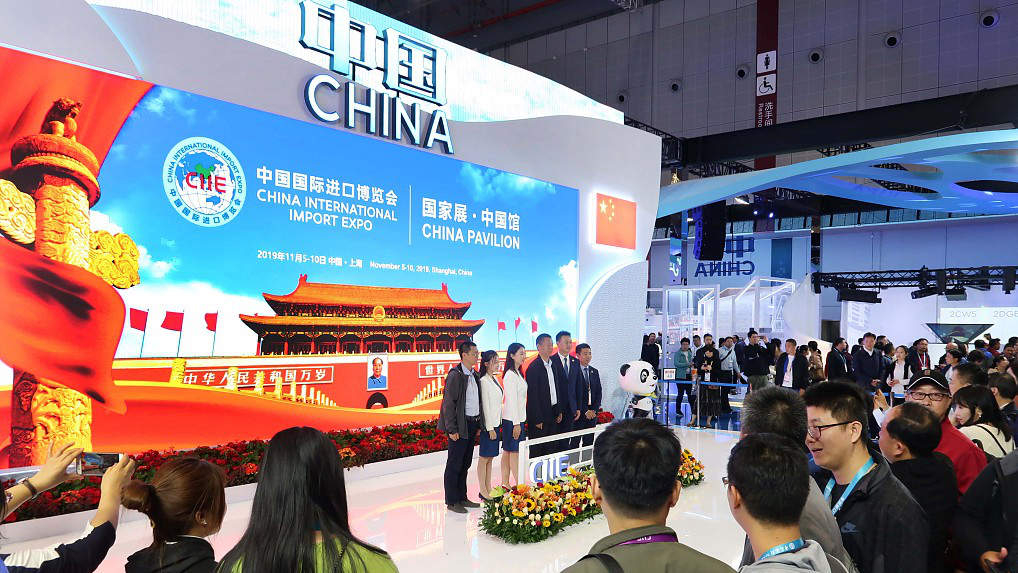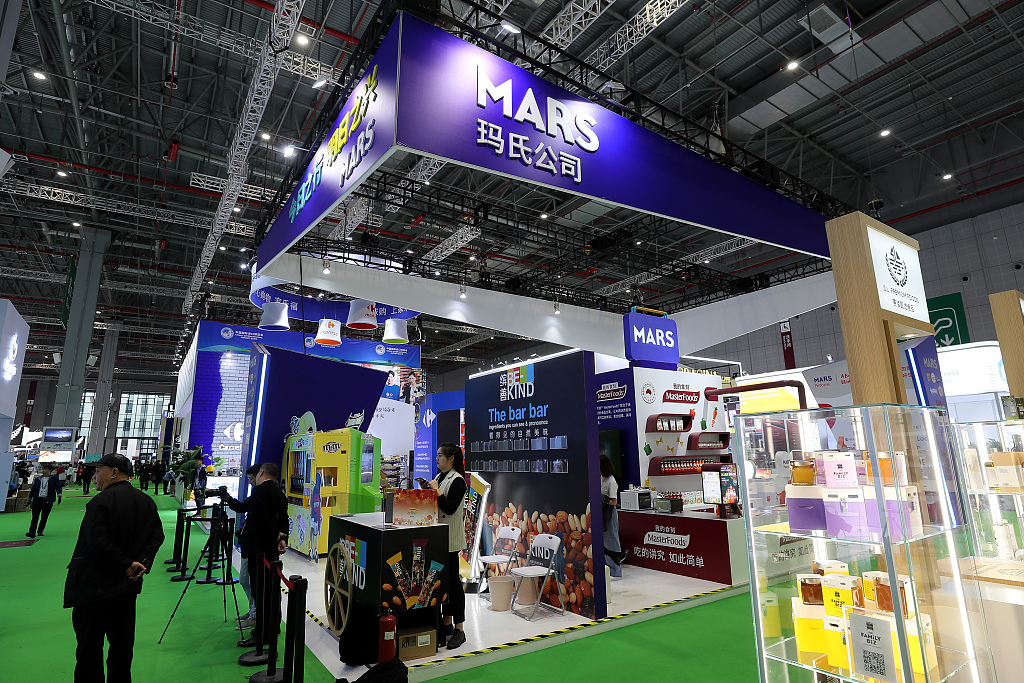
People taking a group photo before China pavilion at the second China International Import Expo, Shanghai, China, Nov 9, 2019. /VCG Photo
People taking a group photo before China pavilion at the second China International Import Expo, Shanghai, China, Nov 9, 2019. /VCG Photo
Editor's note: This article is an edited translation of a Chinese story published on the WeChat accounts of Yuyuantantian on November 7, 2019. The article reflects the authors' opinions, and not necessarily the views of CGTN.
This week, enterprises from all over the world are making the most of their time at the second China International Import Expo (CIIE) in Shanghai. The expo is a grand event that covers an area of 360,000 square meters, of which 47,500 square meters is secured by American businesses, making the U.S. the largest participant at the Expo.
The number of American enterprises at this year's CIIE amounts to 192, an 18 percent increase to that of the last year. Many of them are newcomers to CIIE, such as John Deere, Pfizer, MSD, Exxon Mobil, Corning, Procter & Gamble (P&G) and Microsoft, among others.
Voices of American companies
In the food and agricultural products' exhibition area, there is a wall reviewing a history of the American soybean industry in China from the 1980s to the present. This year, the U.S. Soybean Export Council (USSEC) is representing the American soybean industry at the second CIIE with double the exhibition area.
Zhang Xiaoping, the USSEC Regional Director - Greater China, said that the "history wall" is of special significance as it is the first time for them to show this part of history at the expo and it is expected to remind people to cherish the 40-year long trade relations between China and the United States.
John Heisdorffer, chairman of the American Soybean Association (ASA) and Jacob Parker, director of the United Soybean Board (USB), said that the American soybean industry values the Chinese market, hoping that the two governments can reach a deal at an early date so that the mutually beneficial trade partnership can continue to benefit the industries and people of the two countries.

Staff of the USSEC are talking to visitors, Shanghai, China, Nov. 6,2019. /VCG Photo
Staff of the USSEC are talking to visitors, Shanghai, China, Nov. 6,2019. /VCG Photo
A number of debuts at the CIIE
American enterprises are also debuting a number of new products at CIIE. John Deere, the world's largest farm machinery manufacturer brought its flagship product – the E400 LC crawler hydraulic excavator specially tailored for the Chinese market. Pfizer, the famous U.S.-based multinational pharmaceutical corporation, brought innovative drugs and treatment, including cancer drugs, orphan drugs, antibiotics and vaccines.
Swarming to the CIIE
It is not hard to understand why American enterprises are flocking to the second CIIE. Matthew Price, president of P&G Greater China, said that P&G has been in China's market for more than 30 years, but he still felt a sense of urgency after attending the first CIIE last year. He said that many foreign companies, after their first CIIE experience, have stepped up their efforts in introducing high-end products.
Price said that over the past year, what struck him most was that Chinese consumers are becoming increasingly tech-savvy. In response, to increase the "stickiness" of its products, P&G has accelerated its innovation – it used to take two or three years to introduce a new product, and now it takes only six to nine months. The company saw a 10 percent growth in Greater China in the fiscal year of 2018-2019 and a 13 percent growth in the first quarter of 2019.
Cargill and Mars are both second-time exhibitors at the CIIE. This year, Cargill, the Minnesota-based agricultural giant, has doubled its exhibition space of last year, and is expecting to see a total of trade deals worth over 2.4 billion U.S. dollars. After the first CIIE, Mars invested an additional one billion yuan (about 141.3 million U.S. dollars) in China, including a pet food factory in Tianjin and production lines of the KIND bar and Dove chocolate in east China's Zhejiang Province.

Mars' exhibition booth at CIIE, Shanghai, China, Nov 8, 2019. /VCG Photo
Mars' exhibition booth at CIIE, Shanghai, China, Nov 8, 2019. /VCG Photo
Zhang Yi, president of DuPont Greater China, also said that the company's four major business sectors, namely nutrition and bio sciences, safety and construction, electronics and imaging, transportation and advanced polymers, are closely linked to the current market demand in China, which shows that DuPont attaches great importance to the Chinese market.
According to a CNBC report, U.S. companies are increasingly interested in China's big import event despite the ongoing trade war. Last year, American enterprises that attended the first CIIE reaped substantial benefits, which attracted more American enterprises to this year's CIIE.
The New York Times pointed out that in recent years, China's economy has shifted to one that is much more dependent on domestic consumption. China is now the world's fastest-growing consumer market, with private consumption amounting to about five trillion U.S. dollars, more than 10 percent of the world's total. Facing such a huge pie of trade and economic cooperation, American enterprises surely want to have a slice.
Actively registering for the next CIIE
So far, a total of 115 companies from all over the globe have registered for the third CIIE. Among them, 20 are American enterprises.
Zhang Xiao, CEO of Varian Medical Systems in Greater China, said that although the company was not among the exhibitors, it reached potential deals worth 841 million U.S. dollars during the first CIIE. The magnitude encouraged them so much that last year they had registered for this year's CIIE as exhibitor and now they have already signed up for the third CIIE next year.
Those who had been to the CIIE want to come again, and those who have missed it out have decided to come next time. In a nutshell, American enterprises' enthusiasm about the CIIE proves that no one can afford to lose the Chinese market of 1.4 billion consumers. This also demonstrates American businesses' confidence in China's economic prospect and market potential as well as the overwhelming support for healthy bilateral relations between the two countries.
(If you want to contribute and have specific expertise, please contact us at opinions@cgtn.com.)